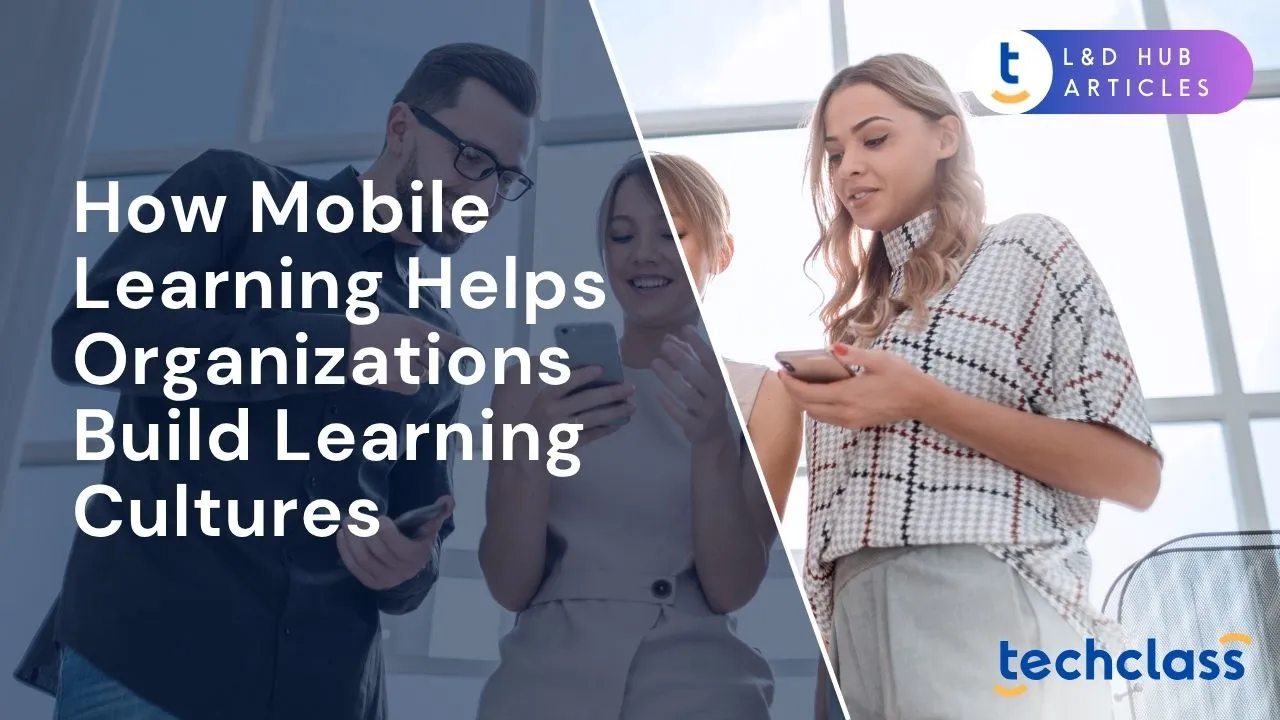
In today’s fast-paced business environment, the ability to learn and adapt is a critical competitive advantage. Companies across industries are recognizing that a strong learning culture, where continuous development is encouraged and valued, can drive innovation, employee engagement, and resilience. In fact, lack of growth opportunities is often cited as the number one reason employees leave an organization, and 94% of employees say they would stay longer at a company that invests in their learning and development [4]. These realities put pressure on HR leaders and business owners to provide effective learning opportunities that fit into employees’ busy lives. This is where mobile learning comes in. With 80% of the world’s population now using smartphones [6] and workers increasingly on the go or working remotely, delivering training via mobile devices has become a game-changer. Mobile learning (or m-learning) allows employees to access educational content anytime and anywhere through their phones or tablets. By meeting learners where they are, whether during a commute or a coffee break, organizations can weave learning into the flow of work and daily life. The result is more consistent, self-driven learning that over time builds a true culture of learning within the organization. In the sections that follow, we’ll explore the importance of a learning culture and examine how mobile learning is helping companies cultivate continuous learning habits, higher engagement, and knowledge-sharing among their teams.
Building an organizational culture that prioritizes learning is no longer a “nice-to-have”, it’s a strategic imperative. A learning culture is an environment where continuous learning is embedded into the company’s values and practices. In such cultures, employees are encouraged to constantly acquire new skills, share knowledge, and apply what they learn to improve performance. This yields multiple benefits for both the organization and its people. For one, companies with strong learning cultures tend to be more innovative and adaptable. They can respond quickly to industry changes because their workforce is continuously updating its skills. As former GE CEO Jack Welch famously noted, the ultimate competitive advantage is an organization’s ability to “learn continuously and apply that knowledge” to outpace competitors.
A learning culture also drives employee engagement and retention. When employees see that their growth is a priority, they feel valued and invested in the company’s future. Opportunities to learn and grow have been identified as a top driver of a positive work culture [4]. Companies that support career development enjoy higher morale and are better able to retain talent. For example, LinkedIn’s Workplace Learning Report found that 94% of employees would stay longer at a company if it invested in their career development [4]. Conversely, if employees feel their skills are stagnating, they may seek growth elsewhere – leading to higher turnover. In summary, nurturing a learning culture helps organizations stay competitive and keeps employees motivated and loyal. However, building such a culture requires making learning accessible and routine, which is where mobile technology offers powerful support.
Mobile learning refers to training and educational content delivered through mobile devices like smartphones and tablets. It has emerged as a critical component of modern workplace learning strategies. The prevalence of mobile devices is a big factor, with most employees owning a smartphone, companies have a direct channel to deliver learning content into the palms of their workforce. Moreover, today’s employees (especially younger generations) expect information on demand and in convenient digital formats. Mobile learning meets these expectations by enabling learning anytime, anywhere, a flexibility that traditional classroom training or desktop e-learning can’t match.
The growth of mobile learning in corporate training has been striking. In 2022, the global mobile learning market was valued around $40 billion and is projected to exceed $100 billion by 2025 (over 20% annual growth) [5]. Around two-thirds of companies have already integrated mobile learning into their training programs, and in North America roughly 74% of organizations are now using mobile learning as part of their L&D strategy [3]. This rise is fueled partly by the shift to remote and hybrid work. With teams spread across locations and time zones, businesses need flexible training methods that reach employees wherever they are. Mobile learning fits this need perfectly, whether an employee is on the road, working from home, or on the shop floor, they can access training materials on their phone.
The convenience of mobile learning is especially vital for frontline and deskless workers who may not have easy access to PCs during the workday. It’s also aligned with how modern professionals consume content. Studies show people often use their smartphones in “downtime” – for example, 52% of learners use mobile learning in bed after waking up, and 46% do so before sleep [3]. By harnessing these small pockets of time, organizations can make learning a continuous daily habit rather than an occasional event. Simply put, mobile learning is transforming corporate training from a scheduled activity into a continuous, on-demand experience, laying the foundation for a pervasive learning culture.
One of the most powerful ways mobile learning helps build a learning culture is by enabling learning anytime and anywhere. In a busy workplace, employees often struggle to find large blocks of time for training. In fact, one survey found the average employee can devote only about 24 minutes per week to formal learning amid their duties [6]. Mobile learning addresses this challenge through flexibility and microlearning. Training content optimized for mobile is typically presented in bite-sized modules – short videos, quick quizzes, brief articles, etc. Employees can easily fit these microlearning sessions into their day, whether during a commute, waiting for a meeting to start, or taking a short break. Over time, these small learning moments add up, reinforcing a habit of continuous learning.
Because learning content is accessible on smartphones around the clock, employees are more likely to engage in just-in-time learning as needs arise. For example, a sales representative about to meet a client can quickly refresh product knowledge on a mobile training app. Or a manager preparing for a difficult conversation can review a short coaching module right before the meeting. This on-demand access means learning is not confined to classrooms or scheduled workshops – it becomes an integral part of the work routine. According to research, mobile-friendly microlearning not only fits into busy schedules but also speeds up training completion. Learners complete courses up to 45% faster on mobile platforms compared to traditional methods [3]. By removing the barriers of time and location, mobile learning encourages employees to learn continuously and proactively. In essence, it creates a culture of pervasive learning, where development isn’t an isolated event but a constant, natural part of the workday. Over time, this normalizes learning as a daily practice, which is a hallmark of a strong learning culture.
Making learning content available is only half the battle, employees also need to find it engaging and worthwhile. Mobile learning helps on this front by leveraging multimedia and interactive elements that boost learner engagement. Training delivered via mobile apps often includes videos, interactive quizzes, gamified challenges, and immediate feedback, which make the experience more interesting than static slide decks or lengthy lectures. This increased engagement translates directly into a stronger learning culture: when people actually enjoy and value the training, they participate more fully and continue seeking out learning opportunities. In fact, studies have shown that learners are significantly more motivated when training is delivered on mobile. For instance, around 70% of learners report feeling more motivated using a mobile device for training versus a computer [3]. This may be due to the convenience and familiarity of smartphones, as well as the engaging formats optimized for mobile screens.
Importantly, mobile learning’s interactivity and bite-sized design also improve knowledge retention. Instead of overwhelming learners with hours of material at once, mobile microlearning reinforces concepts through short, spaced-out sessions. Research indicates that mobile learning can improve retention rates by as much as 35-45% over traditional classroom learning [3][5]. Employees remember more of what they learn, which means they are better able to apply new knowledge on the job – a critical outcome for embedding learning into the culture. Higher engagement also leads to better completion rates for training. Microlearning modules delivered on mobile have an average completion rate around 80%, far exceeding the 20% completion typical of long-form courses [3].
The real-world impact is evident in company case studies. Global companies that have adopted mobile learning often see a surge in employee participation in training. For example, Starbucks introduced a gamified mobile learning platform for its staff and saw a 40% increase in employee participation in training programs, along with a measurable uptick in customer satisfaction (as better-trained employees delivered better service) [5]. In another case, retail giant Walmart implemented mobile-based training for its associates and reported a 20% boost in sales productivity among employees who used the mobile learning app [5]. These examples underscore how mobile learning makes training more engaging and effective, which in turn strengthens the overall learning culture. When employees are actively using learning resources and seeing positive results, it reinforces the belief that continuous learning is valuable – creating a positive feedback loop that sustains the culture.
A robust learning culture thrives not just on individual learning, but also on knowledge sharing and collaboration. Mobile learning platforms often include social features that help foster a community of learning within an organization. Discussion forums, chat functionality, and the ability to share content or tips are commonly integrated into corporate learning apps and Learning Management Systems (LMS). These tools make it easy for employees to ask questions, discuss what they’re learning, and learn from each other’s experiences, even when they are not in the same physical location. This social aspect of mobile learning can break down silos and encourage a culture where employees actively share knowledge.
For example, a salesperson in one region could post a question or a success story on the mobile learning app, and peers across the country can chime in with advice or similar experiences. Such peer-to-peer learning reinforces the notion that everyone in the company has valuable knowledge to contribute – a key mindset in a learning culture. Mobile learning thus facilitates collaborative learning by connecting a diverse and distributed workforce on one platform. As InfoPro Learning notes, mobile solutions can help build “a culture of knowledge sharing to unite your diversified workforce”. Moreover, features like leaderboards or group challenges (if used in a gamified way) can instill a friendly competition and team spirit around learning activities.
This collaborative dimension is especially important for engaging younger employees who often expect social interaction as part of digital experiences. It can also surface internal subject-matter experts, turning employees into teachers and mentors. Over time, having an accessible, company-wide forum for learning discussion nurtures an atmosphere where continuous learning and curiosity are the norm. People become more comfortable seeking help, sharing insights, and celebrating each other’s development. In short, mobile learning platforms can act as social learning hubs that strengthen the collective learning culture of an organization beyond formal training content.
Another way mobile learning contributes to a strong learning culture is by empowering employees to take charge of their own development. In a traditional training model, employees often have little control; they attend scheduled workshops or courses determined by the company. Mobile learning flips this dynamic by putting a vast array of resources and courses literally in employees’ hands, on demand. This encourages a shift from a push-based training model to a pull-based model, where employees can seek out learning when they need or want it. With a well-designed mobile learning platform, individuals can chart personalized learning paths, choose content relevant to their goals, and learn at their own pace. This autonomy is motivating: when people have the freedom to pursue skills or knowledge that interest them, they are more likely to remain engaged and continue learning.
For organizations, fostering this self-driven learning is crucial for a sustainable learning culture. It means employees are not just learning because they’re told to, they’re learning because they have an intrinsic desire to grow. Mobile learning supports this by offering a wide variety of content (from technical skills to soft skills, bite-sized tutorials to deeper dives) accessible anytime. It also often uses AI-driven recommendations or adaptive learning, which suggest new courses or topics based on an employee’s activity, further personalizing the experience. As a result, learning becomes a continuous journey tailored to each individual, rather than a one-size-fits-all event.
Companies that embrace mobile learning also gain better analytics and insights into learning behaviors, thanks to the digital tracking of content usage, course completion, quiz scores, and so on. HR and L&D teams can measure which topics are popular, where knowledge gaps exist, and how learning is impacting performance. These insights allow leaders to support employees more effectively in their growth. When employees see their company actively monitoring and encouraging their progress (for example, through recognition for completing certain learning milestones or gentle nudges to try new modules), it reinforces the value placed on learning. Over time, this creates a virtuous cycle: employees feel empowered to learn, they see their development translating into career growth or better performance, and management continues to invest in learning initiatives that resonate. In essence, mobile learning not only delivers content but helps embed a growth mindset within the workforce, an attitude where employees continually seek to improve themselves, which is the bedrock of a learning culture.
Building a culture of learning is a journey that requires both organizational commitment and the right tools. Mobile learning has proven to be a powerful enabler in this journey. By making learning flexible, engaging, social, and learner-centric, mobile platforms address many of the traditional barriers to continuous learning in organizations. HR professionals and business leaders can leverage mobile learning to meet employees where they are, on their smartphones, and foster an environment where learning is a natural, daily occurrence. The payoff can be substantial: organizations that integrate mobile learning report significant gains in employee engagement and knowledge retention, and even see tangible business outcomes like higher productivity and lower costs [5]. Perhaps most importantly, mobile learning helps send a clear message to employees that learning is valued here. When workers can easily access training on the go, collaborate with colleagues in learning communities, and drive their own development, they feel supported and motivated to grow.
To fully realize these benefits, companies should ensure their mobile learning initiatives align with their overall culture and objectives. This means securing leadership support for learning, curating quality content that is relevant to employees’ roles, and encouraging managers to lead by example (for instance, by taking courses on the app and sharing what they learned). It’s also wise to celebrate learning achievements, many organizations use digital badges or shout-outs for course completions to acknowledge employees’ efforts. Such practices, combined with the technology, help cement the importance of continuous learning in the cultural fabric. In conclusion, mobile learning is more than a convenience; it is a strategic tool to cultivate a learning culture where employees continuously build skills and drive the organization forward. By embracing mobile learning, companies create an agile, knowledge-driven workforce prepared to adapt and thrive in a rapidly changing world.
Building a learning culture helps organizations stay innovative, adaptable, and competitive while boosting employee engagement and retention.
Mobile learning enables employees to access training anytime and anywhere, fitting learning into their daily routines and encouraging ongoing development.
Through multimedia, interactivity, and microlearning, mobile platforms make training more engaging, motivating, and effective, improving knowledge retention.
Mobile platforms include social features like discussion forums and content sharing, fostering peer-to-peer learning and a collaborative learning environment.
It empowers employees to choose relevant content, learn at their own pace, and take responsibility for their development, enhancing motivation and growth.


